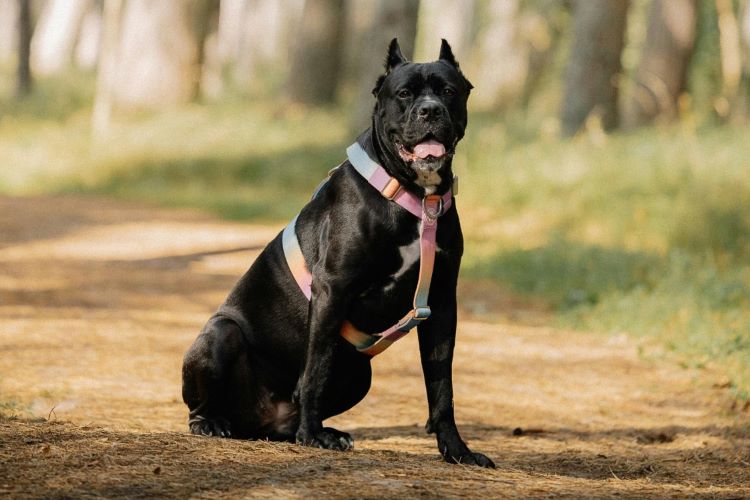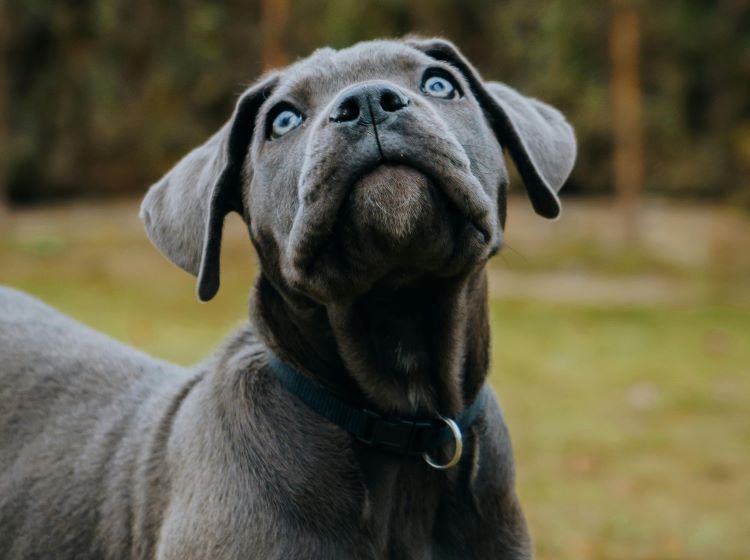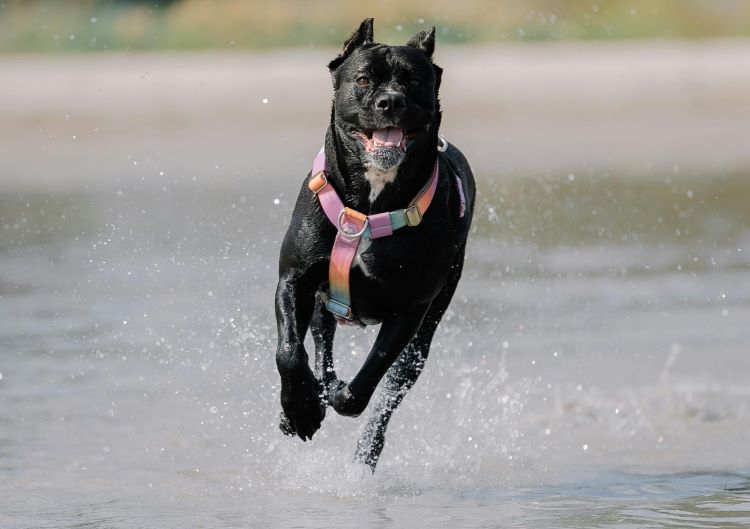Ready to help treat your pet to a healthy life?
Cane Corso Dog Breed: the Guardian Dog
By : Trupanion Staff | Published Feb 27, 2025

If you’ve ever gotten to know a Cane Corso, you may recognize them as a strong, versatile breed willing to go above and beyond for its favorite humans. You may also be aware that they’re subject to a lot of misconceptions. Are Cane Corsos dangerous? Were they really used as war dogs in ancient Rome? Do they make great family pets today?
In this guide, we’ll dive into the Cane Corso with breed history, care tips, and more. Let’s kick things off with some interesting facts!
8 fun facts about Cane Corsos
- The name "Cane Corso" roughly translates to "guardian dog" or “bodyguard dog” in Latin, highlighting their natural protective instincts.
- They’re also known by their Italian name, the Cani Corsi (“Corsi” is also the plural form of the breed, though “Cane Corsos” is still commonly used).
- The Cane Corso’s bite force is estimated to be 700 PSI (pounds per square inch), which is stronger than many other breeds, including Rottweilers and Pit Bulls.
- Despite their large size, Cani Corsi are agile and athletic, excelling in activities like obedience, agility training, and even dock diving.
- They have short coats that require minimal grooming, though they do shed moderately throughout the year.
- Cani Corsi are known for their intense, expressive eyes, which can seem almost human-like in their ability to communicate emotions.
- They “Talk.” Instead of barking excessively, Corsi often use grumbles, groans, and "talking" sounds to communicate with their owners.
- Despite their tough appearance, Cane Corsos can be very affectionate and love being close to their owners, often following them from room to room.
Breed description
So, what is a Cane Corso exactly? If you’ve never seen one in real life, this dog is certainly memorable due its size. A large, Italian mastiff breed or “molossoid,” these dogs stand tall and strong. Exact breed standards can vary somewhat between kennel clubs and fancier organizations. Typically, purebreds meet the following criteria:
Size: Large; males typically weigh 100-120 lbs (45-54 kg), females 85-100 lbs (39-45 kg).
Height: 23.5-27.5 inches (60-70 cm) at the shoulder.
Build: Muscular but not overly stocky, with a square head and long, powerful limbs.
Coat: Short, dense, and stiff; comes in colors like black, fawn, gray, brown, and brindle.
History of the Cane Corso dog breed
Cane Corsos were not recognized as their own official breed until 1994 in Italy (and not until 2010 in the US!), but their origins go back much further. Legend has it that the breed once accompanied Roman soldiers into battle, but there are no clear records of these war dogs being the same as modern Corsi. Instead, it was likely an earlier Molossian ancestor who did so.
According to the Fédération Cynologique Internationale (the largest international federation of national kennel clubs and purebred registries), the Cane Corso was once widely prevalent across the Italian peninsula, where it was commonly used as a guardian for livestock, families, and rural businesses.
By the early 1900s, the Cane Corso started showing decline, eventually being found mostly only in the southern region of Puglia. The breed’s decline accelerated after the collapse of Italy’s mezzadria sharecropping system in the 1960s, as the breed’s role in rural life diminished. By then, only a handful of these powerful dogs remained. However, in the 1980s, dedicated breeders launched a revival, carefully selecting and breeding the last surviving Corsi to restore the breed. Thanks to their efforts, the Cane Corso has since reclaimed its place as a valued guardian dog around the world, well-regarded for its endurance, intelligence, and strong sense of loyalty.
Similar dog breeds
- Neapolitan Mastiff
- Presa Canario
- Boerboel
- Bullmastiff
- Dogo Argentino
- Rottweiler
Breed temperament and training
Early socialization and puppy training classes are recommended for all dogs, but they’re absolutely essential for a powerful breed like the Cane Corso. This breed has strong dominant and protective instincts, so early socialization is vital for helping them grow into well-mannered, well-balanced companions.

Obedience training is likewise key to ensuring Corsi respect their humans as leaders, rather than taking charge themselves. Thankfully, these pups tend to be smart, eager to learn, and highly trainable (especially when starting early). Don’t be fooled by their tough exteriors either — these dogs have big hearts and thrive on love, positive reinforcement, and rewards far more so than harsh, punishment-based training methods.
That said, you may want to consider enlisting the help of a dog trainer for proper guidance. Be sure to look for someone experienced with Cane Corsos or similar dog breeds. Follow these tips to find the right trainer for you and your pet.
Is the Cane Corso aggressive?
Corsi have a history of being labeled an aggressive dog breed, but the truth is that they are not inherently dangerous. Unfortunately, many people adopt these dogs without properly training them or meeting their daily exercise and enrichment needs. When this happens, Corsos can become more easily agitated or fail to act safely around certain triggers. This is why proper training early in a Cane Corso’s life is so important — it keeps dogs, humans, and other animals around them safe.
Is the Cane Corso illegal anywhere?
Some US states and Canadian provinces have the Cane Corso listed as a restricted dog breed due to its reputation for being aggressive. Although the dog’s aggression still comes down to training and environment, it’s important to adhere to local laws if you’re considering adopting one. As of 2025, the Cane Corso is subject to breed-specific legislation (also known as BSL) in the following states:
- Kansas
- Arkansas
- Idaho
- Colorado
- Nebraska
- South Dakota
- Washington
- Oregon
Keep in mind that dog breed restrictions can be on a city level as well, even if they’re not outright banned by the state or province. Always check both city and state dog ownership rules. For example, the city of Denver bans Corsi while the state of Colorado does not. Likewise, many municipalities across Canada have strict regulations on the Cane Corso breed despite there being no large-scale blanket bans.
Breed health and care tips
Cane Corsos are a generally healthy dog breed. However, like all large dogs and breeds with a more limited genetic pool, they do have some potential health concerns to watch for. Common issues in Cani Corsi include (but are not limited to) the following:
- Hip and elbow dysplasia
- Canine bloat
- Heart issues (specifically Dilated Cardiomyopathy or DCM)
- Eyelid problems (both Entropion and Ectropion)
- Skin and coat issues
- Obesity and joint stress
- Cherry eye
To reduce the likelihood of serious health problems from the get-go, it’s a good idea to choose a reputable Cane Corso breeder who tests for genetic health issues. But regardless of where you get your pet, early detection of health issues is key. So, keep up with routine veterinary care for your Cane Corso. It’s also crucial to feed your dog a vet-approved diet rich in quality protein and joint-supporting nutrients. They’ll also need daily exercise as well as both indoor and outdoor activities that keep their intelligent minds stimulated.
Pet insurance for Cane Corsos
Focusing on providing your dog with a healthy lifestyle and regular veterinary care are paramount to their health and well-being. That said, you can’t fully predict or necessarily prevent future illnesses and injuries. Pet insurance coverage for Cane Corsos is a smart investment due to their size and predisposition to health issues like hip dysplasia, bloat, and heart disease.
If you’ve never heard of pet insurance (also called “dog insurance”), it’s becoming more common, especially for at-risk breeds. Veterinary bills for large dog breeds in particular can be costly. A good pet insurance plan can help cover unexpected medical expenses, helping your Cane Corso get the best care without financial stress.
Learn more about how pet insurance works.

Cani Corsi in pop culture
Cane Corsos have made a strong impression in movies, often cast as intimidating yet loyal guardians. Their powerful build and commanding presence make them perfect for roles as protectors, police dogs, or even villains’ companions. While not as commonly seen as German Shepherds or Rottweilers, Cane Corsos have appeared in films like the John Wick series and Columbiana, as well as TV shows like The Blacklist, Atlanta, and Game of Thrones. Whether playing a fierce protector or a devoted companion, Cane Corsos bring an undeniable presence to the big screen.
Celebrities with Cane Corsos
Corsi have gained more popularity in recent years, including among famous people. Here are some examples!
- Patti LaBelle — singer and actress
- Vin Diesel — actor
- Lebron James — athlete
- Jamal Lewis — athlete
- Dwayne “The Rock” Johnson — actor and former pro wrestler
- James Maddison — athlete
- Marcus Rashford — athlete
- Megan Thee Stallion — musical artist
